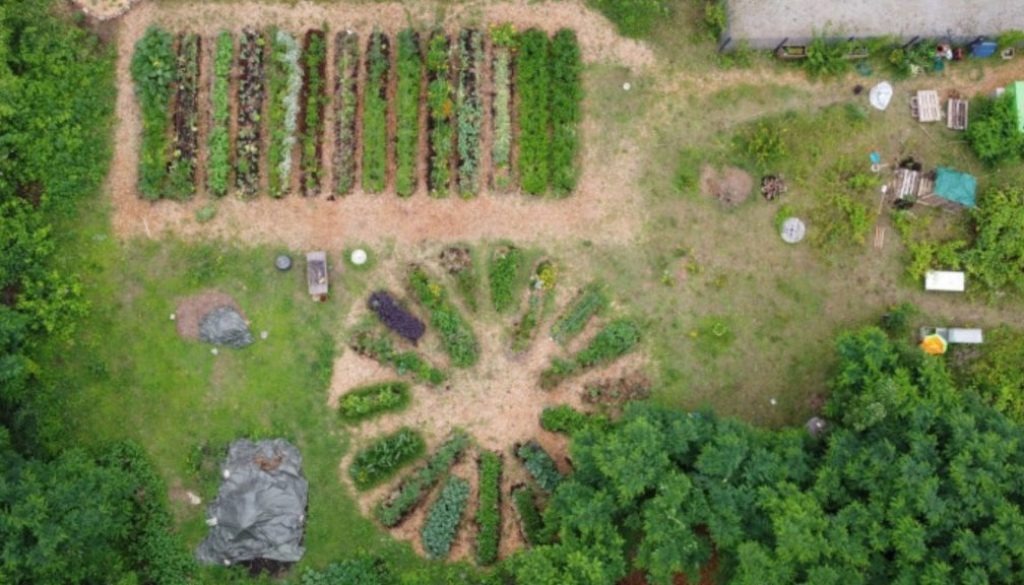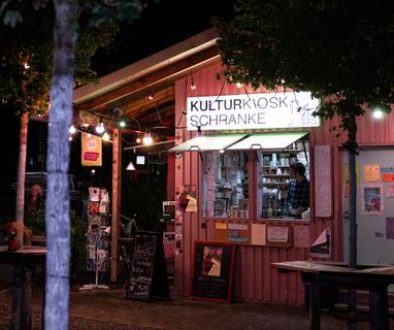Where the big things grow
The vegetable heroes want to make Frankfurt edible by jointly creating permaculture gardens across the city. Despite adversity, they have expanded enormously in a short period of time. Her recipe for success: serenity, cohesion – and a pinch of megalomania.
“We were megalomaniacs from the start, we had to be,” says Laura Setzer, holding a small bag full of freshly harvested wild herbs. Behind her, high buildings tower into the early autumn city sky, only a few meters away, cars are speeding down the Hansaallee, occasionally a honking breaks through the roar of traffic. Setzer is located on the university campus in Frankfurt’s Westend, in a fenced garden area. Lovingly tended beds line the approximately 2,000 square meter property, lettuce sprout here, palm cabbage, leeks, staghorn plantain. A blackboard hangs on a small wooden shed on which someone has written down some to-dos with chalk. “Remove blackberries from beds”, “Cut tomatoes & aubergines at ground level” and – with an exclamation mark – “Harvest!”.
Together with her partner Juliane Ranck, the gardener collective that they initiated and students of the Goethe University Frankfurt am Main , Setzer has been caring for the garden, which has been laid out according to the principles of permaculture, since the spring months of 2021 . Those involved call the social meeting place PermaKultur Insel , the harvest of which is already rich and one hundred percent edible, just a few months after sowing.
The nucleus of the project is almost three kilometers east of the campus, in the so-called “green lung”. Anyone familiar with Frankfurt local politics will know this name. Because on the 16 hectare garden area in the north end, some investors* together with the city plan to build a housing estate, mostly high-priced apartments. Several civil society initiatives are loudly campaigning for the preservation of the site and its more than 2,000 trees in the course of the development plans.
When Ranck and Setzer stumbled into an unused, overgrown part of the garden area at the beginning of 2019, they got caught up in the front lines of the conflict. Because they knew immediately: This is it, the ideal place for the implementation of their vision.
The vision of Ranck and Setzer – and this refers to the megalomania mentioned at the beginning – is a change in diet, preferably nationwide. “The subject of food has fascinated us for a long time,” says Ranck. After all, diet makes up a third of the ecological footprint and is an important lever in the fight against climate change. It makes sense to use her passion for gardening to support herself and as many others as possible – in the middle of the city. The ground that has never been built over and the intact ecosystem of the green lung seemed to offer optimal conditions for regenerative “urban farming”. At this point at the latest, the city’s development plans also became a problem for Ranck and Setzer.

Instead of arguing with the authorities, Ranck and Setzer took a different, less complicated approach: They just got started. “The area was so neglected and littered that we could only do better,” says Laura Setzer, making a sweeping hand movement. A good two and a half years have passed since then and this place, where Ranck and Setzer talk about their project in bright sunshine and in high spirits, really doesn’t look neglected anymore. Neatly arranged beds stretch out to the left of the small garden gate, to the right is a picnic table behind a self-made pond, in the corner tall conifers frame a wooden tool shed.
There are a total of 14 beds here in the “Market Garden”, says Juliane Ranck, while carefully walking between the rows of plants and occasionally picking up a few orange-yellow pineapple cherries. As is usual in permaculture, the beds are planted throughout the year. The greatest possible yield should be achieved on a small amount of soil, because you want to “disrupt” as little soil as possible. On the other hand, year-round planting requires a variety of species, each with different needs, which in turn feed, complement and support each other – just like in a natural ecosystem. Rather than machines and chemicals, permaculture relies on in-depth knowledge of these systems to mimic them. An approach that convinced Rankk and Setzer right from the start.
After bypassing bureaucratic hurdles and initially only a few garbage disposal campaigns, the project quickly became a sure-fire success. Some tenants who had become aware offered the vegetable heroines the opportunity to help manage their gardens, and Peter Beckmann from the citizens’ initiative to preserve the Green Lung arranged for them gardens that would become vacant. They are now planting 16 gardens in the Green Lung. Ranck and Setzer – both career changers in the profession of permaculture – only realized after a few crop failures that most of them are not sunny enough for growing vegetables. Both of them face setbacks like this calmly. “When we fail, something new always emerges,” says Setzer. In the shady gardens, for example, places for exchange and meetings were created.
More than 250 people are meanwhile among the vegetable heroes , gardening and making decisions and enriching the project with their own skills. Ilka Wittig, for example, has drawn up detailed cultivation plans for all gardens in order to avoid future crop failures; the artist Michaela Heidlas-May has transformed the formerly littered “Werklaborgarten” into an open studio, where creative workshops and shared meals for all hungry and interested people take place regularly.
The vegetable heroines are confident that the offers will be well received. “We’re at an exciting point right now,” says Ranck. Shortly after her first book was publishedUrban Farming“ the second book project is already in the works (there is one in progress at the momentcrowdfunding campaign). They also want to found an academy soon. It is important to the vegetable heroines to remain a social project despite expansion. “Even people who don’t go to the organic supermarket should pick their own lettuce here,” says Setzer, while she harvests her evening meal back on the Westend campus. The remaining harvest is distributed to passers-by in the Green Lung on a donation basis, and since June 2021 the vegetable heroes have also been delivering to the “Wir Komplizen” restaurant in Frankfurt Bornheim once a week. Sometimes they also supply a canteen in the Bockenheim district and Fridays-for-Future demos.
“We see ourselves as part of an urban community,” emphasize the vegetable heroines. Because natural ecosystems are not closed and isolated from their environment, cooperation with other institutions and organizations is “lived permaculture” for them.
Despite all past differences regarding the green lung, the vegetable heroes also work closely with the city of Frankfurt, which abandoned the aforementioned development plans after the Greens won the municipal elections in 2019. Now the vegetable heroes are once again confronted with development plans: A school is to be built on the campus garden. “We will not take action against this,” confirm Ranck and Setzer. Are you worried about the future of your project given these plans? The two women dismiss it: “We follow the same motto as in the Green Lung: We act as if it will go on forever and hope that it will become a self-fulfilling prophecy.” Is that megalomaniac?
PS: The vegetable heroes now also want to fly high . They are currently looking for roofs in Frankfurt that they can make greener, more edible and more beautiful together.




